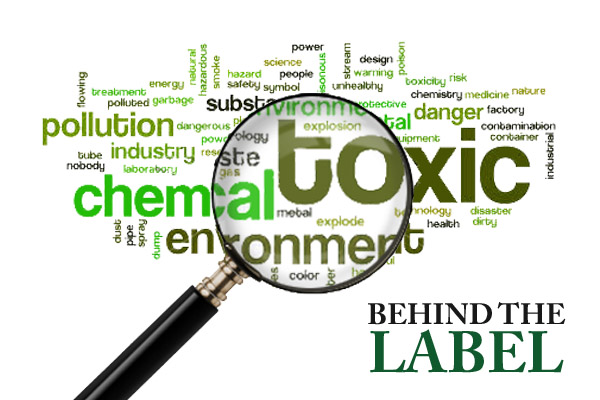Behind the Label: Calvin Klein Eternity

What’s in your perfume bottle? Pat Thomas dissects the ingredients of Eternity by Calvin Klein, uncovering a sweet smelling array of carcinogens, neurotoxins and hormone disruptors.
What’s the difference between perfume and pollution? Absolutely nothing. Perfumes may be sold as luxury items that enhance our wellbeing and sexuality, but at heart they are composed of neurotoxic solvents not dissimilar from those favoured by glue sniffers and volatile chemicals usually more at home in garages and industrial factories.
As far back as 1986, the US National Academy of Sciences targeted fragrance ingredients as one of six categories of neurotoxic chemicals in need of thorough investigation. This placed perfume ingredients right up there with insecticides, heavy metals, solvents and food additives as primary causes of disease in humans. But government and industry have been slow to get their acts together.
Under EU legislation there are few restrictions and even fewer outright bans on the quantities or combinations of fragrance chemicals that may be used in cosmetics. A typical perfume contains a mixture of fragrance chemicals (often between 50 and 100) mostly derived from petroleum. These include benzene derivatives, aldehydes and many other known toxins capable of causing cancer, birth defects, central nervous system (CNS) disorders and allergic and asthmatic reactions.
These substances can get into the body by inhalation or by being absorbed through the skin. When fragrance chemicals penetrate the skin they can be toxic to the liver and kidneys.
Still others accumulate in fatty tissue and leach slowly back into the system or are passed on to children via breast milk.
Inhaled, they can cause sore throat, runny nose, sinus congestion, wheezing, shortness of breath, nausea, headache, dizziness, lethargy, mood swings and muscle pain. Perfume chemicals not only affect users but also those around them, and there are now urgent calls for second-hand scent to be considered in much the same light as we consider second-hand smoke.
There are environmental concerns as well, since fragrances are volatile compounds, which add to both indoor and outdoor air pollution. Synthetic musk compounds, for example, are carcinogenic and potential endocrine disrupters. They are also persistent in the environment and contaminate waterways and aquatic wildlife.
The turnover of the fine fragrance market in the UK was £350 last year. Calvin Klein’s Eternity accounts for 3.1 per cent of the total market. Currently, the US Food and Drug Administration is considering a petition submitted by US environmental group the Environmental Health Network to have Eternity declared ‘misbranded’. The basis of the petition is that none of the perfume’s ingredients have been adequately tested for safety.
The ingredients of Eternity are fairly representative of those found in all modern perfumes. While most women perceive it as a romantic floral fragrance, the reality is quite different. Of Eternity’s 41 known ingredients, 33 have no relevant safety data. Of the rest, data suggests they are toxic, irritant, sensitising (capable of causing allergic-like reactions), damaging to the CNS and carcinogenic. Accordingly, the campaigners want the label of this (and all other perfumes) to caution: ‘Warning: the safety of this product has not been determined.’
Sidebar: Ingredients in Calvin Klein Eternity Eau De Parfum
Iso E Super, Lilial, Benzyl salicylate, Diethyl phthalate, Beta-ionone, Lyral, Alpha-terpineol, Piperonal, Galaxolide 50, Methyl dihydrojasmonate, Linalyl acetate, CIS-3-hexenyl salicylate, Eugenol, Ethyl linalool, Citronellol, Cyclopentadecanolide, Alpha-ionone, Benzyl acetate, Geranyl acetate, Octanol 7-hydroxy-3, 7-dimethyl-, 2-Buten-1-ol, 2-ethyl-4-(2,2,3-trimethyl-3-cyclopenten-1-yl), Benzenethanol, 1-Cyclohexene-1-butanol 4-(diethoxymethyl)-.alpha.,.alpha.-dimethyl-, 2-Buten-1-one, 1-(2,6,6-trimethyl-1-cyclohexen-1-yl)-, Benzaldehyde,4-hydroxy-3-methoxy-, Phenol, 2-methoxy-4-(1-propenyl)-, Oxacycloheptadec-10-en-2-one-, 2-Octanol, 8,8-diethoxy-2,6 dimethyl-, 2-Propen-1-ol, 3-phenyl-, 6-Octen-3-ol, 3,7-dimethyl-, acetate, 6-Octen-3-ol, 3,7-dimethyl-, 7-Octen-4-one, 2,6- dimethyl-, Acetic acid, (cyclohexyloxy)-, 2-propenyl ester, 2,6-Octadien-1-ol, 3,7-dimethyl-, Phenol, 2,6-bis(1,1-dimethylethyl)-4-methyl-, Benzaldehyde, 4-methoxy-, Benzenemethanol, 1,3,6-Octatriene, 3,7-dimethyl-, Benzoic acid, 2-hydroxy-,ethyl ester
Benzyl acetate
Purpose
- Synthetic fragrance (floral, fruity)
Adverse effects
- Irritating to eyes and respiratory passages
- Carcinogen, linked to pancreatic cancer
Benzenethanol
Purpose
- Synthetic fragrance (sweet, floral, rose)
Adverse effects
- Irritating to skin, eyes and upper respiratory tract
- CNS disruption
- Carcinogenic
- Also affects bone marrow (the tissues that produce blood cells); Exposure can lead to aplastic anaemia, excessive bleeding, and damage to the immune system (by changes in blood levels of antibodies and loss of white blood cells)
Diethyl phthalate
Purpose
- Solvent; carrier; fixative
Adverse effects
- Irritating to eyes and skin
- CNS disruption
- Causes fetal abnormalities
- Sperm damage
- Oestrogen mimic
- Carcinogen
Eugenol
Purpose
- Synthetic fragrance (clove oil substitute)
Adverse effects
- Irritant
- Contact dermatitis
- Also a common fungicide, pesticide and insecticide ingredient
Ethyl linalool; Linalool
Purpose
- Synthetic fragrance (bergamot, French lavender)
Adverse effects
- Narcotic
- CNS disruption
- Commonly used in pesticides
Alpha-terpineol
Purpose
- Synthetic fragrance (floral)
Adverse effects
- Highly irritating to mucous membranes
- CNS disruption
- Scientific data warns against repeated or prolonged skin contact
Galaxolide 50
Purpose
- Synthetic fragrance (artificial musk)
Adverse effects
- Hormone disruptor
- Irritant
- Carcinogenic
Cyclopentadecanolide
Purpose
- Synthetic fragrance (artificial musk)
Adverse effects
- Hormone disruptor
- Irritant
- Carcinogenic
Benzaldehyde,4hydroxy-3-methoxy
Purpose
- Synthetic fragrance (vanilla)
Adverse effects
- Irritation to the mouth, throat, eyes, skin, lungs, and the gastrointestinal tract, causing nausea and abdominal pain
- Kidney damage
- CNS disruption
Benzenemethanol
Purpose
Solvent (carrier for other fragrance chemicals); synthetic fragrance (sweet, floral)
Adverse effects
- Irritating to skin, eyes and upper respiratory tract
- CNS disruption
- Carcinogen
Phenol, 2,6-bis(1,1dimethylethyl)-4methyl
Purpose
- Fragrance; antioxidant
Adverse effects
- Irritant
- Potential carcinogen
- Reproductive toxin
- Also used as a pesticide
- This article first appeared in the November 2004 edition of the Ecologist.












